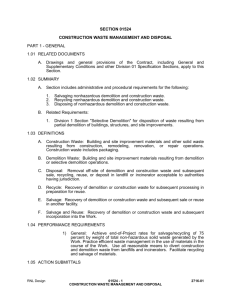Why Burning Is Bad - Vermont Agency of Natural Resources
advertisement
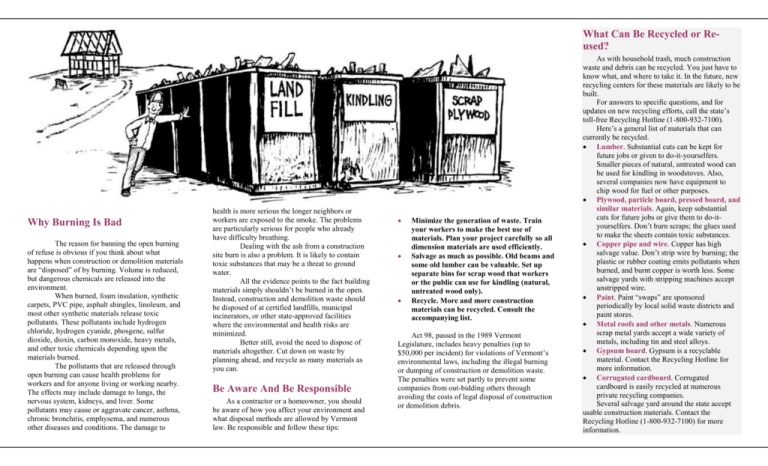
What Can Be Recycled or Reused? Why Burning Is Bad The reason for banning the open burning of refuse is obvious if you think about what happens when construction or demolition materials are “disposed” of by burning. Volume is reduced, but dangerous chemicals are released into the environment. When burned, foam insulation, synthetic carpets, PVC pipe, asphalt shingles, linoleum, and most other synthetic materials release toxic pollutants. These pollutants include hydrogen chloride, hydrogen cyanide, phosgene, sulfur dioxide, dioxin, carbon monoxide, heavy metals, and other toxic chemicals depending upon the materials burned. The pollutants that are released through open burning can cause health problems for workers and for anyone living or working nearby. The effects may include damage to lungs, the nervous system, kidneys, and liver. Some pollutants may cause or aggravate cancer, asthma, chronic bronchitis, emphysema, and numerous other diseases and conditions. The damage to health is more serious the longer neighbors or workers are exposed to the smoke. The problems are particularly serious for people who already have difficulty breathing. Dealing with the ash from a construction site burn is also a problem. It is likely to contain toxic substances that may be a threat to ground water. All the evidence points to the fact building materials simply shouldn’t be burned in the open. Instead, construction and demolition waste should be disposed of at certified landfills, municipal incinerators, or other state-approved facilities where the environmental and health risks are minimized. Better still, avoid the need to dispose of materials altogether. Cut down on waste by planning ahead, and recycle as many materials as you can. Be Aware And Be Responsible As a contractor or a homeowner, you should be aware of how you affect your environment and what disposal methods are allowed by Vermont law. Be responsible and follow these tips: Minimize the generation of waste. Train your workers to make the best use of materials. Plan your project carefully so all dimension materials are used efficiently. Salvage as much as possible. Old beams and some old lumber can be valuable. Set up separate bins for scrap wood that workers or the public can use for kindling (natural, untreated wood only). Recycle. More and more construction materials can be recycled. Consult the accompanying list. Act 98, passed in the 1989 Vermont Legislature, includes heavy penalties (up to $50,000 per incident) for violations of Vermont’s environmental laws, including the illegal burning or dumping of construction or demolition waste. The penalties were set partly to prevent some companies from out-bidding others through avoiding the costs of legal disposal of construction or demolition debris. As with household trash, much construction waste and debris can be recycled. You just have to know what, and where to take it. In the future, new recycling centers for these materials are likely to be built. For answers to specific questions, and for updates on new recycling efforts, call the state’s toll-free Recycling Hotline (1-800-932-7100). Here’s a general list of materials that can currently be recycled. Lumber. Substantial cuts can be kept for future jobs or given to do-it-yourselfers. Smaller pieces of natural, untreated wood can be used for kindling in woodstoves. Also, several companies now have equipment to chip wood for fuel or other purposes. Plywood, particle board, pressed board, and similar materials. Again, keep substantial cuts for future jobs or give them to do-ityourselfers. Don’t burn scraps; the glues used to make the sheets contain toxic substances. Copper pipe and wire. Copper has high salvage value. Don’t strip wire by burning; the plastic or rubber coating emits pollutants when burned, and burnt copper is worth less. Some salvage yards with stripping machines accept unstripped wire. Paint. Paint “swaps” are sponsored periodically by local solid waste districts and paint stores. Metal roofs and other metals. Numerous scrap metal yards accept a wide variety of metals, including tin and steel alloys. Gypsum board. Gypsum is a recyclable material. Contact the Recycling Hotline for more information. Corrugated cardboard. Corrugated cardboard is easily recycled at numerous private recycling companies. Several salvage yard around the state accept usable construction materials. Contact the Recycling Hotline (1-800-932-7100) for more information. Air Pollution Control in Vermont The Vermont Air Pollution Control Division was established to maintain and improve the quality of Vermont’s air. Clean air will safeguard our citizens’ health and safety, promote economic and social development, and enhance enjoyment of the state’s natural attractions. The program described in this pamphlet is one of several administered by the Department of Environmental Conservation as part of this mission. Proper disposal of construction and demolition waste Is essential to avoid damage to the environment And to avoid human health hazards. Construction and Demolition Waste Building, Tearing Down, Renovating: Waste Is Produced In Many Ways E very year roughly 195,000 tons of construction and demolition waste (not including asphalt and concrete) is generated in Vermont. The waste comes from many sources: from homeowners renovating a room to large contractors building housing developments, shopping malls, and offices. Since 1986 over 10,000 new housing units have been constructed in Vermont. In addition, since 1980 well over 8,000 seasonal housing units have been built. And as new structures are going up, old ones are coming down. The specific types of waste generated depend on the project. Typically, demolition projects produce large amounts of natural wood, painted or treated wood, asphalt roofing materials, floor coverings such as linoleum and carpeting, insulation, coated wiring, plastic bathroom fixtures, Questions? For more information about the burning of construction and demolition waste, and other air pollution issues, call the Air Pollution Control Division at (802) 241-3840. The Division can also supply additional copies of this brochure. For more information on recycling, call the Recycling Hotline at 1-800-932-7100. Air Pollution Control Division Building 3 South 103 South Main Street Waterbury, VT 05671-0402 Pamphlet No. 4, January, 1992 Source of statistical information: “Recycling Construction and Demolition Waste in Vermont”, Vermont Agency of Natural Resources, December, 1990. Managing It Responsibly counter tops, plumbing materials, asbestos, and even appliances. New construction generates many similar materials, as well as foam insulating board, particle board, plywood, vinyl siding, paint buckets, plastic pipe, compound buckets, and pressure-treated lumber. Proper disposal of these wastes is essential to avoid environmental damage and potential health hazards. In February 1989, a state Solid Waste Management rule went into effect prohibiting the open burning of any solid waste except untreated wood. Under this rule, it is illegal to burn particle board, chip board, plywood or similar wood products, pressure-treated lumber, cardboard, paper, materials containing asbestos, asphalt roofing materials, insulation, or any other synthetic materials.
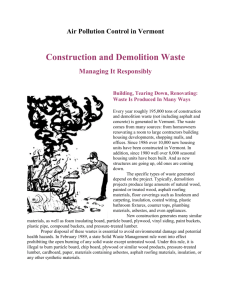


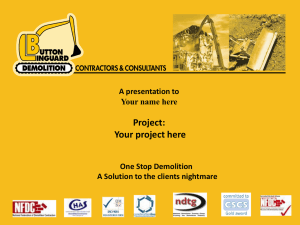


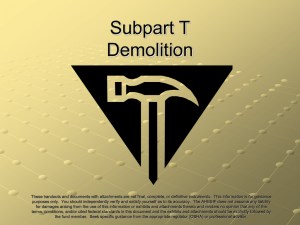
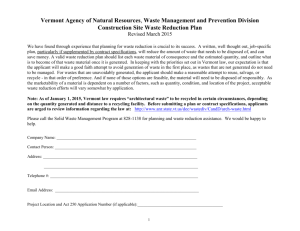
![School [recycling, compost, or waste reduction] case study](http://s3.studylib.net/store/data/005898792_1-08f8f34cac7a57869e865e0c3646f10a-300x300.png)
